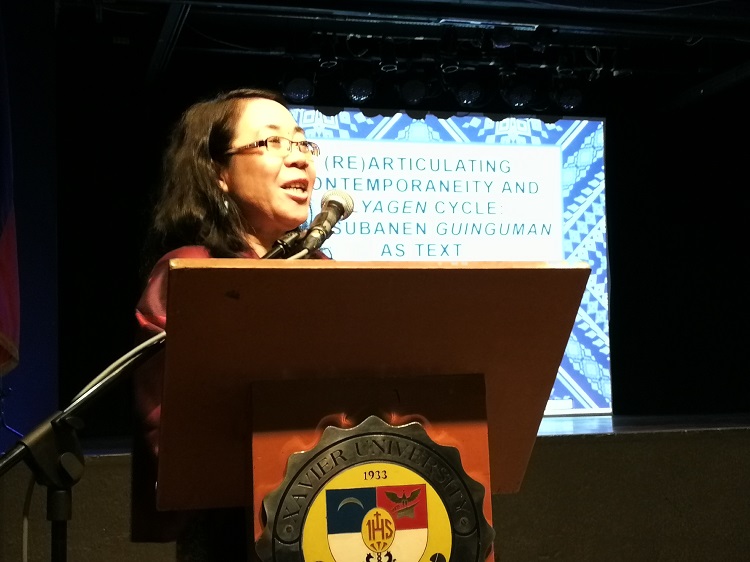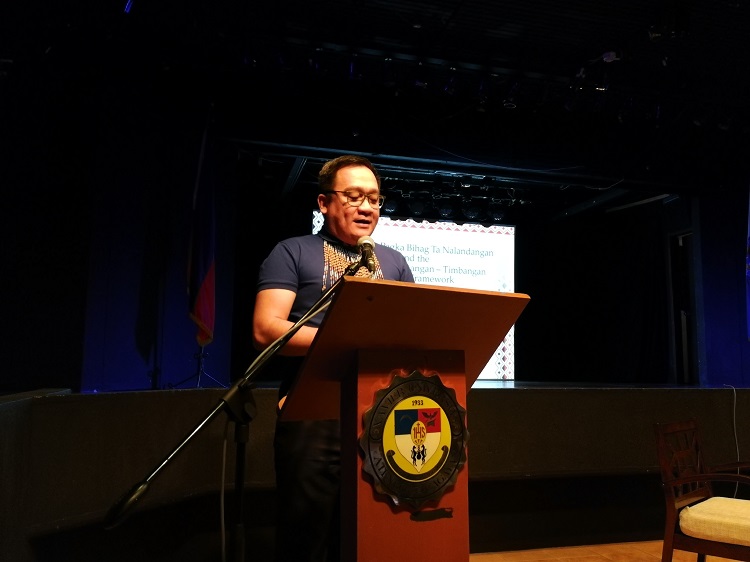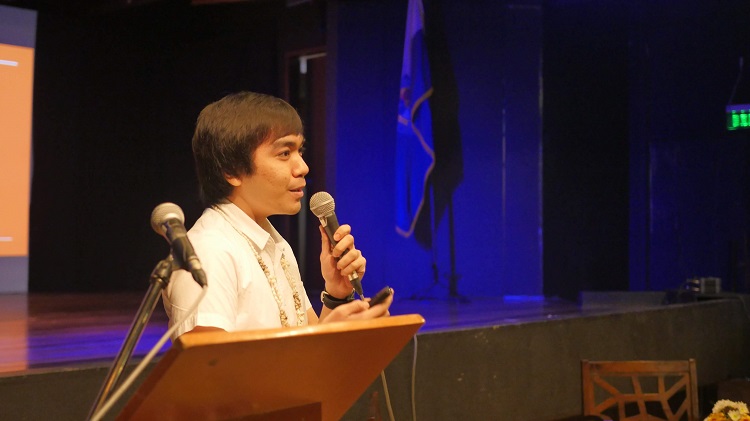
ANALYZING EPICS. Mindanao State University - Iligan Institute of Technology's Dr Ivie Carbon Esteban shares her MA thesis on analyzing the text and narrative of the Subanen’s Ginguman.
The National Commission for Culture and the Arts (NCCA) recognizes October as the National Indigenous Peoples’ Month. Pursuant to Presidential Proclamation 789, NCCA also pays tribute to museums, galleries, and their curators this month.
The 11th installment of the Yamug series by the Xavier Center of Culture and the Arts (XCCA) has integrated these commemorations into one academic conference on Wednesday, October 3, at the XU Little Theater.
With topics ranging from XCCA’s current digitization project to immortalizing the collected archives within the Museo de Oro to Mindanaoan folk epics that have been handed down from one generation to another, Yamug 11 was attended by educators and students from various schools in Cagayan de Oro City and Northern Mindanao.
The lecture series first opened its doors for academic discussions in 2008 under the leadership of XCCA director Hobart Savior. The name was coined by Museo de Oro’s former assistant curator and resident artist Nonoy Estarte. The Visayan termYamug is translated as "mist." Conducted annually, the lecture series involves academic discussions that are aimed to demystify the prejudice imposed against the diverse people of Mindanao and promote the crafts that are part of their heritage.
As a flagship project under the cultural education program of XCCA, it is part of Xavier Ateneo’s conscious effort as a university to preserve authentic Filipino culture, tradition, and identity.
“Today’s focus is very appropriate and important,” Xavier Ateneo's VP for mission and ministry Irene Guitarte said during her opening remark, referring to the discussions.
As preservation and promotion for culture continue today, history also finds its way in the present as attested by XCCA’s digitization project.
Preserving the pieces of evidence of history
“Why should we remember?” Cagayan de Oro-based writer and XCCA publicist Angelo Lorenzo asked the rhetorical question to the audiences in his lecture about the culture and arts program’s initiative to digitize historical documents archived within the Museo de Oro.
Lorenzo, who is currently taking his Master of Arts in Literature in the university, has been tasked to document the progress of Handuraw sa Kinaadmanong Bahandi sa Mindanao (Image of the Treasured Wisdom of Mindanao) - A Digitization of Archival Collections of Museo de Oro since the project began in July this year.
With the primary objective to preserve the historical documents’ contents, the project was spearheaded by XCCA and supported by NCCA. Employing filmmakers to handle the digitization process, a workshop was conducted in July before this was initiated, with National Committee on Archives’ assistant secretary Rosemarie Roque leading the training. Museo de Oro archivist Irene Saway-Llesis had oriented the team about the proper way to handle the documents before the digitization process began. Llesis also currently serves as the project coordinator.
As of September, the digitization team has amassed 85% progress, with the contents of four collections copied from their fragile tangible pages into the virtual computer through scanning and photography. These four collections include the Hayes Collections, Elio Collections, Elio Collections of Old Books, and Fr Francisco Demetrio SJ Collections. These comprise records or religious rites and sacraments presided in municipalities of Northern Mindanao, newspapers circulated in Camiguin and Cagayan de Oro, and Mindanaoan folk epics that had been compiled into voluminous books in hardcovers. Some of these documents date back to the Spanish colonization and American occupation of the Philippines, preceding the Second World War.
Lorenzo further shared in his lecture that XCCA is looking forward to the digitization project’s completion by the end of October. Plans to collaborate with Xavier Ateneo’s Computing and Information Services Office (CISO) for a database where the digitized documents will be stored will be conceptualized and initiated for the accessibility of these documents as resource materials for the university’s community and the CDO public.
“We remember because there are events in history that will help us understand the present and will serve as a basis for making sense of what may come in the anticipated future,” he stated.
By sharing the value of preserving pieces of evidence of history, discussions within the forum also sought to reveal the significance of sustaining heritage and culture.

SOCIAL METAPHORS IN ULAGING. Xavier Center for Culture and the Arts director Hobart Savior relates the social realities of the Talaandig tribe to their sacred epic that narrates about how their idyllic place has been captured by invading forces and was eventually retrieved by the Talaandig hero Agyu, together with his son.
Finding facts in folk narratives
One of the speakers in Yamug 11, XCCA director Hobart Savior shared his dissertation to the audience. Advocating for the rights and welfare of Lumads in Mindanao, particularly the Talaandig community in Lantapan, Bukidnon, Savior presented the tribe’s folk narrative, “Pagka Bihag ta Nalandangan" (The Capture of Nalandangan), on which his research is based.
Savior’s dissertation angled over an in-depth study about this narrative. “Their Nalandangan is their hagiographic world or universe,” he stated. This sacred realm as an idyllic place to the Talaandig can be likened to the Arthurian legend’s Camelot and JRR Tolkien’s Middle Earth.
This is the realm where the series of epics comprised in Ulaging — the basis of their beliefs, faith, and customs which encompasses text similar to the Christian Bible — took place. The narrative tells about how Nalandangan was swallowed whole by an invader who transformed into a serpent and how Agyu, the hero emulated by the community, embarked on an adventure to save them with the aid of his son.
But like many epics, the narrative is an allegory relative to present-day issues concerning the Talaandigs.
“This study reflects the community struggle and survival as it reclaims the domain (Nalandangan) that was stolen and captured by the invaders,” Savior noted.
As a social metaphor, invasion does not literally come in the form of a gigantic snake, but, as Savior explained, slithers as “forces that threaten the Talaandig’s way of life, their culture, and their identity.”
This is reflective to the capitalist investors that had grabbed the ancestral domains of the indigenous people in the absence of their consent and blessing.
“The Talaandigs’ land had been stolen by capitalist investors who did not ask permission from them,” Savior said. “They could not enter their ritual grounds and sacred spaces because these have already been occupied.”
In the same way, cosmopolitan mentality and contemporary influences can be hindrances for the youth of the Talaandig to appreciate and sustain their culture and traditions. “These may cause detachment and displacement between the youth and the Ulaging,” Savior added.
This gap widens when the youth become too detached from their language that they become unfamiliar with it. Since this epic is formally narrated through a sacred ritual, the youth, which will inherit the community’s traditions, are challenged to master the rite in order to retain their customs and pass on the knowledge to future generations. As they have been exposed to their cultures and traditions, the Talaandig youth constantly strive to sustain the identity and inherit the legacy of their community through these practices.
This insight bodes well with the lecture presented by Dr Ivie Carbon Esteban from the Mindanao State University - Iligan Institute of Technology's English Department.
Like Savior’s dissertation, Esteban’s master’s thesis focused on the sacred text of an indigenous community. But when Savior focused on the Talaandigs, Esteban ventured among the Subanen. Her research tackled about the text and the themes found within the Ginguman, the epic narrative that is equivalent to the Talaandigs’ Ulaging.
The epic revolves around the ancient territory of Thubig Dlyagen, which is similar to the Talaandigs’ Nalandangan, the realm that identifies with the people’s survival and identity.
As the Subanens also struggle to preserve their culture and retain their tradition, Esteban defined the specifics of this problem in her lecture.
“If we transform epic into text, it loses its performative characteristic,” she remarked. “An epic chanting ideally should have a ritual; because it is the ritual that would give the essence of the singing and the performance.”
Because of this, the apathy of the next generations has to be addressed.
Like many allegories, these folk epics do not merely exist by tradition but represent and reflect the current circumstance and realities of the communities.
This is why, like preserving history, these epics are sustained for reference and basis for an ideal life in the present.

REMEMBERING HISTORY. Xavier Center for Culture and the Arts publicist Angelo Lorenzo shares the progress of the Handuraw Project, XCCA’s initiative to preserve the archived historical documents in Museo de Oro through digitization.
Relevance in the present
Esteban admitted that the Ginguman didn’t end the way narratives should be. In her words, she considered the ending to be “hanging.” But when she asked her narrator, a Subanen native, about this concern, she learned that their stories still continue as long as their tribe thrives.
“There is wisdom in that,” she said. “The tribes are bounded with a lot of stories and narratives; as long as the Subanen lives, their stories still continue.”
This reality marks the relevance of their narratives in the present time. For the Talaandigs, however, the Ulaging relates with the framework of their constitution, concept of equality, and the aspiration for balance.
Savior detailed in his lecture about the Agpangan-Gantangan-Timbangan cultural framework which is encouraged by Datu Anastacio Saway for the Talaandigs to follow. Agpangan constitutes the basis of their ethics, in determining right from wrong, and defines the standard of their principles. Gantangan establishes equality within the community, wherein everyone must receive the fair share of resources and no one is more privileged than the other. Lastly, Timbangan weighs the balance of aspects in life - from work effort to rest and misery to happiness.
These epics’ relevance in the present-day help the indigenous community anchor on their pride and identity, especially in not letting go of their history and traditions.
“They want to create allies instead of enemies,” Savior shared, giving emphasis on how the Talaandigs have resolved the issues concerning their communities by confronting the capitalist investors in courtesy, and receiving justice and the consequential benefits they deserve.
***
Perspectives about history, heritage, and identity may change, but in order to understand and appreciate their existence, discussions, and discourses must delve into their depths and significance.
As Mindanao is made up of diverse people and has undergone through the best and worst of times in history, opportunities to preserve and reflect on who the people are and what they’ve been through should not be taken for granted. As a lecture series, Yamug has pursued this initiative as one among the many.∎